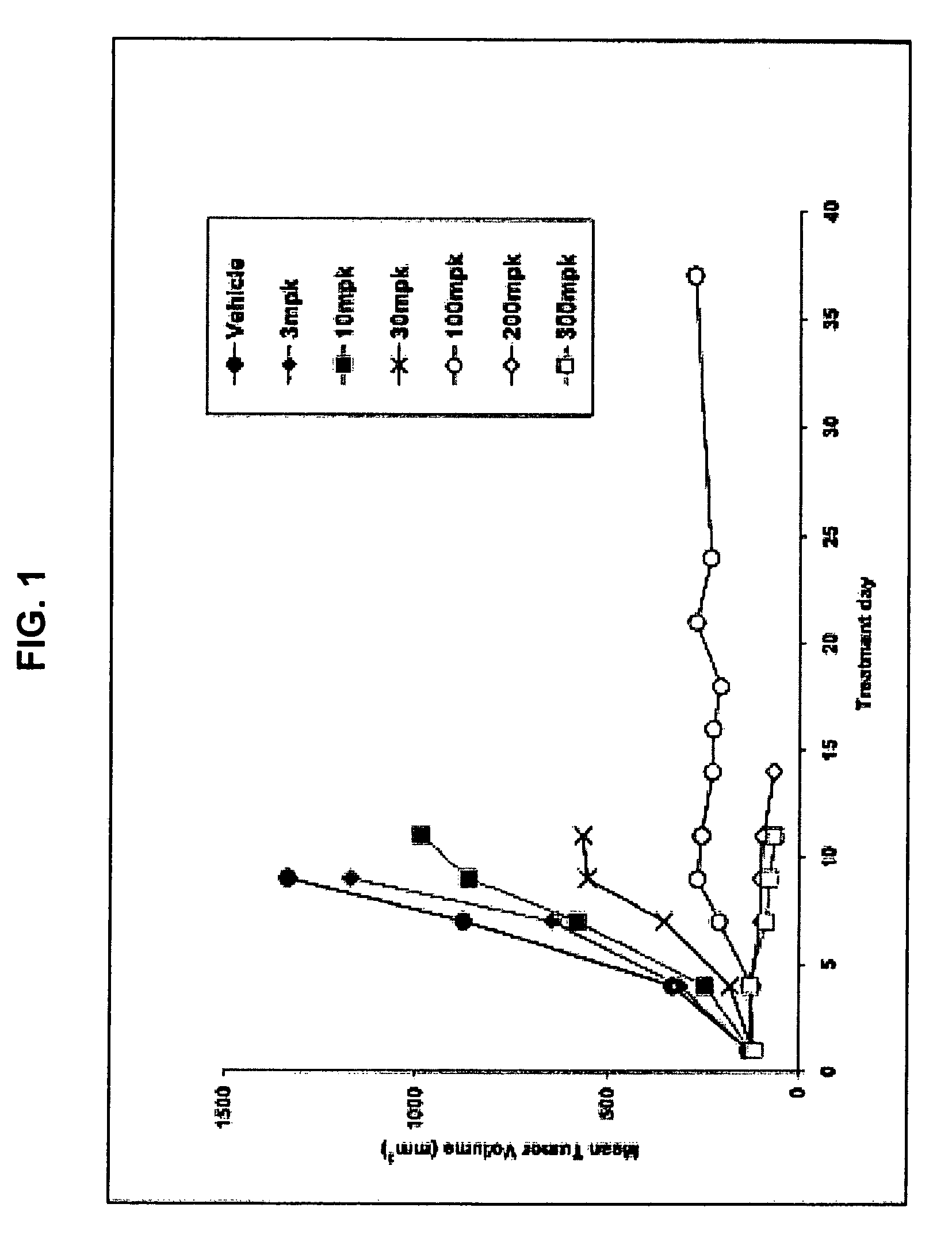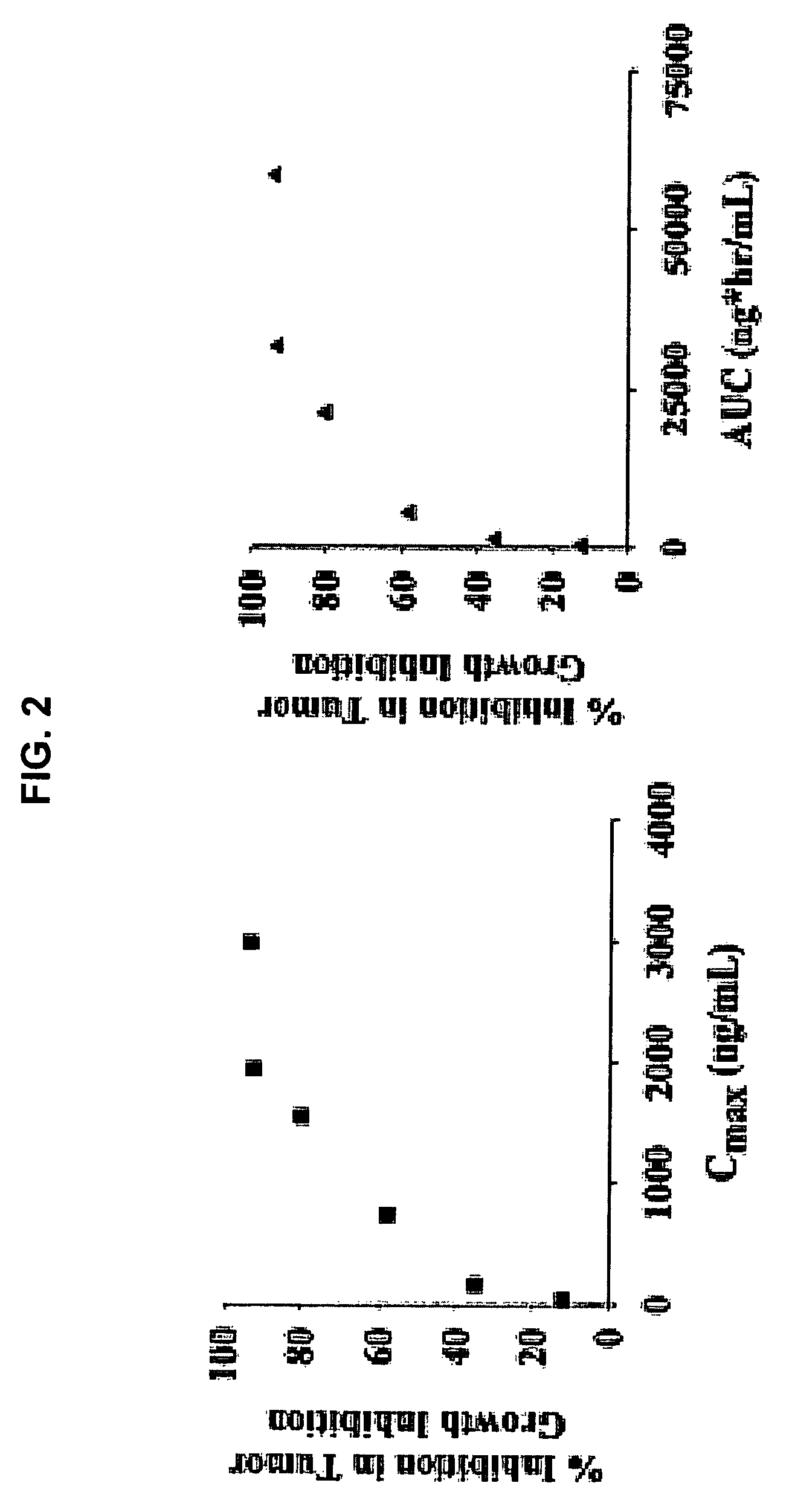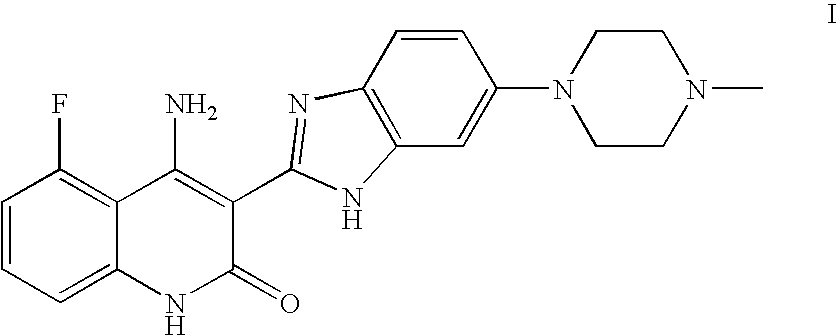Methods of treating cancer and related methods
a receptor tyrosine kinase and cancer technology, applied in the direction of biocide, heterocyclic compound active ingredients, drug compositions, etc., can solve the problems of pdgfr kinase activity with small molecules, interfere with tumor growth and angiogenesis,
- Summary
- Abstract
- Description
- Claims
- Application Information
AI Technical Summary
Benefits of technology
Problems solved by technology
Method used
Image
Examples
example 1
[0156]The antiproliferative activities of 4-amino-5-fluoro-3-[6-(4-methylpiperazin-1-yl)-1H-benzimidazol-2-yl]quinolin-2(1H)-one (compound 1) were tested against a large number of cancer cell lines and primary non-malignant cell lines. Methods were as follows: Cells were plated in 96-well plates; after three to five hours gelling time for adherent cell lines delusions of the compounds were added, three days later viable cells were determined by adding MTS solution (Promega). Absorbance at 490 nm was measured and EC50 values calculated using non linear regression. For the HMVEC assay, compounds were incubated with the cells for three days in the presence of five ng / mL recombinant VEGF. For the SCF / c-KIT assay the TF-1 and H526 cells were incubated for three days in the presence of 40 ng / mL and 100 ng / mL recombinant SCF, respectively. Proliferation was assayed by adding MTS solution and measuring the absorbance at 490 nm. EC50s were calculated by non-linear regression. Results are sho...
example 2
[0160]Two metabolites of compound 1 were identified and partially characterized in pooled rat plasma from a 2 week toxicology study. Day 1 and day 14 dosed animal plasmas were analyzed by UV and LC / MS from once a day 30 or 80 mg / kg, PO, dose groups. The two identified metabolites were the piperazine N-oxide compound of formula II (compound 2) and the N-demethylated compound of formula III (compound 3) (see Example 6 for synthesis and characterization of these compounds). Estimated levels of the metabolites (based on UV absorbance and in comparison to known levels of compound 1 quantified in the same samples from previous analyses) are given in Table 2. The N-desmethyl metabolite was found to be in substantially lower abundance than compound 1 in all samples of post dosed pooled plasmas. The N-oxide metabolite was observed to be present in lower abundance than compound 1 except at 24 hours on day 14 in the 80 mg / kg dose group and 1-2 hours on day 1 in the 30 mg / kg dose group (Table 2...
example 3
In Vitro Kinase Assays for Receptor Tyrosine Kinases
[0163]The kinase activity of a number of protein tyrosine kinases was measured by providing ATP and an appropriate peptide or protein containing a tyrosine amino acid residue for phosphorylation, and assaying for the transfer of phosphate moiety to the tyrosine residue. Recombinant proteins corresponding to the cytoplasmic domains of the FLT-1 (VEGFR1), VEGFR2, VEGFR3, Tie-2, PDGFRα, PDGFRβ, and FGFR1 receptors were expressed in Sf9 insect cells using a Baculovirus expression system (InVitrogen) and may be purified via Glu antibody interaction (for Glu-epitope tagged constructs) or by Metal Ion Chromatography (for His6 (SEQ ID NO: 1) tagged constructs). For each assay, test compounds were serially diluted in DMSO and then mixed with an appropriate kinase reaction buffer plus ATP. Kinase protein and an appropriate biotinylated peptide substrate were added to give a final volume of 50-100 μL, reactions were incubated for 1-3 hours at...
PUM
| Property | Measurement | Unit |
|---|---|---|
| Time | aaaaa | aaaaa |
| Time | aaaaa | aaaaa |
| Mass | aaaaa | aaaaa |
Abstract
Description
Claims
Application Information
 Login to View More
Login to View More - R&D
- Intellectual Property
- Life Sciences
- Materials
- Tech Scout
- Unparalleled Data Quality
- Higher Quality Content
- 60% Fewer Hallucinations
Browse by: Latest US Patents, China's latest patents, Technical Efficacy Thesaurus, Application Domain, Technology Topic, Popular Technical Reports.
© 2025 PatSnap. All rights reserved.Legal|Privacy policy|Modern Slavery Act Transparency Statement|Sitemap|About US| Contact US: help@patsnap.com



